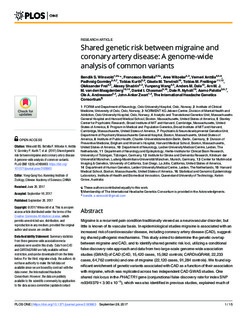| dc.contributor.author | Winsvold, Bendik K S | |
| dc.contributor.author | Bettella, Francesco | |
| dc.contributor.author | Witoelar, A | |
| dc.contributor.author | Anttila, Verneri | |
| dc.contributor.author | Gormley, Padhraig | |
| dc.contributor.author | Kurth, Tobias | |
| dc.contributor.author | Terwindt, Gisela M | |
| dc.contributor.author | Freilinger, Tobias | |
| dc.contributor.author | Frei, Oleksandr | |
| dc.contributor.author | Shadrin, Alexey A. | |
| dc.contributor.author | Wang, Yunpeng | |
| dc.contributor.author | Dale, Anders | |
| dc.contributor.author | Van Den Maagdenberg, Arn M.J.M. | |
| dc.contributor.author | Chasman, Daniel I | |
| dc.contributor.author | Nyholt, Dale R | |
| dc.contributor.author | Palotie, Aarno | |
| dc.contributor.author | Andreassen, Ole Andreas | |
| dc.contributor.author | Zwart, John-Anker | |
| dc.date.accessioned | 2018-01-26T09:42:09Z | |
| dc.date.available | 2018-01-26T09:42:09Z | |
| dc.date.created | 2018-01-25T13:23:55Z | |
| dc.date.issued | 2017 | |
| dc.identifier.issn | 1932-6203 | |
| dc.identifier.uri | http://hdl.handle.net/11250/2479797 | |
| dc.description.abstract | Migraine is a recurrent pain condition traditionally viewed as a neurovascular disorder, but little is known of its vascular basis. In epidemiological studies migraine is associated with an increased risk of cardiovascular disease, including coronary artery disease (CAD), suggesting shared pathogenic mechanisms. This study aimed to determine the genetic overlap between migraine and CAD, and to identify shared genetic risk loci, utilizing a conditional false discovery rate approach and data from two large-scale genome-wide association studies (GWAS) of CAD (C4D, 15,420 cases, 15,062 controls; CARDIoGRAM, 22,233 cases, 64,762 controls) and one of migraine (22,120 cases, 91,284 controls). We found significant enrichment of genetic variants associated with CAD as a function of their association with migraine, which was replicated across two independent CAD GWAS studies. One shared risk locus in the PHACTR1 gene (conjunctional false discovery rate for index SNP rs9349379 < 3.90 x 10−5), which was also identified in previous studies, explained much of the enrichment. Two further loci (in KCNK5 and AS3MT) showed evidence for shared risk (conjunctional false discovery rate < 0.05). The index SNPs at two of the three loci had opposite effect directions in migraine and CAD. Our results confirm previous reports that migraine and CAD share genetic risk loci in excess of what would be expected by chance, and highlight one shared risk locus in PHACTR1. Understanding the biological mechanisms underpinning this shared risk is likely to improve our understanding of both disorders. | nb_NO |
| dc.language.iso | eng | nb_NO |
| dc.publisher | Public Library of Science | nb_NO |
| dc.rights | Navngivelse 4.0 Internasjonal | * |
| dc.rights.uri | http://creativecommons.org/licenses/by/4.0/deed.no | * |
| dc.title | Shared genetic risk between migraine and coronary artery disease: A genome-wide analysis of common variants | nb_NO |
| dc.type | Journal article | nb_NO |
| dc.type | Peer reviewed | nb_NO |
| dc.description.version | publishedVersion | nb_NO |
| dc.source.volume | 12 | nb_NO |
| dc.source.journal | PLoS ONE | nb_NO |
| dc.source.issue | 9 | nb_NO |
| dc.identifier.doi | 10.1371/journal.pone.0185663 | |
| dc.identifier.cristin | 1551813 | |
| dc.description.localcode | © 2017 Winsvold et al. This is an open access article distributed under the terms of the Creative Commons Attribution License, which permits unrestricted use, distribution, and reproduction in any medium, provided the original author and source are credited. | nb_NO |
| cristin.unitcode | 194,65,30,0 | |
| cristin.unitname | Institutt for nevromedisin og bevegelsesvitenskap | |
| cristin.ispublished | true | |
| cristin.fulltext | original | |
| cristin.qualitycode | 1 | |

